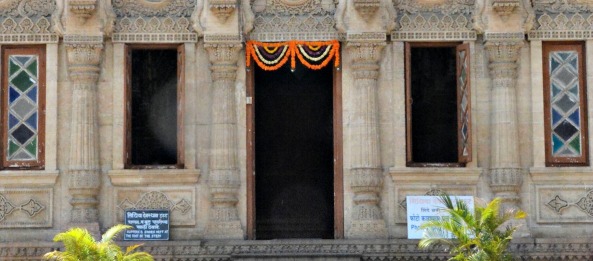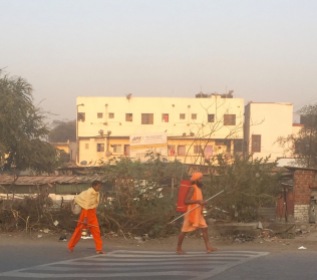Pune, India, February 2017.
I arrived back from my first trip to India a week ago.
An opportunity for a visit with the Other Half, who had business meetings, the new Indian e-visa system allowed me to decide 4 days before the flight to jump at the chance.
Destination, Pune in the state of Maharashtra.
Considered to be the cultural capital of Maharashtra, Pune is also known as “Oxford of the East” due to the presence of several well-known educational institutions in the city. One of the fastest growing cities in India, the city is known for its manufacturing, automobile and IT research institutes.
Historically there is evidence of a settlement from around 858AD and during British rule in India (1818-1947) a large military cantonment was built. The city was known as Poona during British rule.
As the e-visa allows you to enter India via certain cities, our best connection was via Hyderabad. A late flight, a very long connection, but take note, Indian airport security is intense and three hours were needed to change from international arrivals to domestic departures, check in, pass security and we were left with 30 mins before departure.
Note to self, for future visits, patience and a long connection time is required.
As I had 2.5 days in which to maximise my Pune experience and not being terribly sure about wandering around town alone, I thought the best way would be to find a walking tour.
Very luckily Mr Google found me Pune Magic and within an hour of my first email I had a reply and duly booked a day car trip and a half day walking tour.
The day tour, with guide and driver titled “Pune, a journey through history”, was just that.
Having arrived with a quick Wiki-ed speed read about the city, our wonderful guide Mrs Daya, took us from the past to the present.
We had landed at 7.30am, having flown overnight, with snatched sleep on the plane, checked into the hotel, a quick wash and then downstairs to meet our no-nonsense guide.

Driver, AC car, the fabulously knowledgeable Daya and me, looking keen after no sleep… I didn’t look quite so bright around 4pm…
Off we went in our air-conditioned car into a swirling maelstrom of morning traffic to our first destination. Somewhat jaded we sat back behind the glass barriers of our car windows and watched Pune wake up for work. Lane control doesn’t exist and it was a frantic introduction to India. Hordes throng the sidewalks, buses, lorries, cars, auto-rickshaws, bicycles, scooters and the cacophony of horns constantly blaring. I watched it all amazed.
Sidewalk sleepers, vendors, beggars, but all surrounded by such colour. From the sarees and blankets hung over fences, the vibrant orange and red flowers and the women, dressed in their gaily patterned sarees and kurtas, India swirled into my vision.
Leaving the madness of the road we went to the university area to see the Governor Generals mansion, which is within the university grounds. Pune is known as an academic centre, “The Oxford of the East” with emphasis on research. One of the largest banyan trees in the city is within the grounds and the grassy areas were full of students sitting in the shade. The rather majestic building that housed the Governor General was having repair work done to the outside walkways but gazing at it and imagining life in those days, it was easy to feel the colonial past.

Rangoli designs on the ground, I don’t know why it’s there, but it looks wonderful and the detail of work is impressive…

It is a large building, you wouldn’t expect it not to be…

One set of main doors… I feel crinolines and pith helmets may have belonged here…

Finally caught the chipmunk…

Security smiling…

Doors along the walkway…

Yours truly, dwarfed by the Banyan tree..
Onwards to the British World War Cemetery, beautifully maintained by the Commonwealth War Graves Commission.The soldiers that died fighting for the Empire came from all denominations and countries. Muslims, Jews, Buddhists, Hindus, Christians all are buried here together. Islamic epitaphs, the Star of David and a cross on each tombstone denotes religion and the ages range from 17 onwards. It is respectfully kept and a moving reminder to those soldiers who lost their lives. A tranquil place amidst the city madness.
Then a drive through richer and leafier parts of the city where homes are hidden behind high walls and security guards manage entry to the lives behind.
Amidst these tranquil streets, The Osho Meditation ashram is found. Strict security and photos are forbidden, so alas no pictures of an interesting view into the ashram watching the morning dance meditation.
Followers must wear long red robes whilst attending the ashram and for a while, we stood and watched the free expression dancing, the majority seemed to be white westerners.The bottom line is that it is an expensive place to be, karma or no karma. I was fascinated, there has been nothing like this in my life and having watched a tiny part, I don’t think there will need to be, but each to their own.
The ashram was made famous by its inceptor Bhagwan Shree Rajneesh, who was an Indian Godman and leader of the Rajneesh movement.
During his lifetime he was viewed as a controversial mystic, guru, and spiritual teacher. In the 1960s he travelled throughout India as a public speaker and was a vocal critic of socialism, Mahatma Gandhi and Hindu religious orthodoxy. He advocated a more open attitude towards human sexuality, earning him the sobriquet “sex guru” in the Indian and later international press, although this attitude became more acceptable with time.
Mrs Daya had some interesting input and some wry and witty observations regarding our questions. We moved on from Osho, amused and enlightened.

The only photo I was allowed to take, Buddha behind bars…
The Aga Khan palace is a place of importance in Indian history. Built by Sultan Muhammed Shah Aga Khan III in 1892, it is one of the biggest landmarks in Indian history.
The palace was an act of charity by the Sultan who wanted to help the poor in the neighbouring areas of Pune, who were drastically hit by famine.
Mahatma Gandhi, his wife and secretary were held here under house arrest from 9 August 1942 to 6 May 1944 and his loyal wife, Kasturba Gandhi passed away here.
In 1969, Aga Khan Palace was donated to the Indian people by Aga Khan IV as a mark of respect to Gandhi and his philosophy. Today the palace houses a memorial for Gandhi where his ashes are kept.
This palace is also the headquarters of the Gandhi National Memorial Society. It was an Indian schools picnic day before the end of year, on our visit, so the grounds were filled with children and youngsters dressed up for the occasion.
Onwards to St Mary’s Church, Pune, built in 1825. The church was built to meet the spiritual needs of the British soldiers stationed in and around Pune. Nowadays it falls under the jurisdiction of the Church of North India and a 1,500 strong congregation worships there each Sunday. The memorial plaques on the church walls tell the tale of the British in India. “Succumbed to fever” and “Killed in action” feature against many memorials.
Then to Shinde Chhatri, a memorial to 18th-century military leader Mahadji Shinde.The Anglo-Rajasthani style of construction with exquisite and detailed carvings and an imposing three storey facade. Within the building is a temple dedicated to Lord Shiva.
Chhatri means umbrella in Marathi. As a sign of respect to the great warrior, visitors are required to close their umbrellas inside the premises, even if it is raining.
By this stage, my companions were flagging so we decided to take a slow drive, instead of a walk through the Shivaji Market area, a decision I regretted as soon as we started to drive through the small streets overhung by old houses and seeing the life outside my car window. But none of us had slept much in the last 24 hours and they had meetings, so, back to the JW Marriott, me for a shower and the Executive floor for a sunset drink and the workers to do big business, mine was the better option!
Visa:
India now has an e-visa system. For a British passport this works ok, but only for two trips in 12 months. It’s an online application, a little daunting as for some reason parental information is required ( even if you are 60), not 100% user-friendly, but have your passport to hand as you work through, plus saved copies of a recent photo, in a reduced format that matches the upload requirement.
Flights:
International: Emirates to Hyderabad- 3 times daily. Hyderabad is one of the 16 entry airports in India that accepts the e-visa. The e-visa queue had us three in it, whereas the normal immigration channels were catering for at least 500 people. We got through very quickly but luggage waiting time was over an hour.
Internal:
Outward: Jet Airways to Pune, 3-hour connecting time- needed. Interminable queues for security. Separate queues for men and women, so hang onto your boarding card if you are separated as it needs to be stamped for security. Lighters are forbidden and blue tooth earphones seemed to be an issue. Generally, a good idea to pack cables together in a plastic bag too otherwise they all get dragged out.
Inward: Air India to Hyderabad. Delayed, slightly tatty and the fastest turnaround and push back I have ever experienced. Faintly concerning but I’m sure the pilot knew his stuff, we arrived on time.
Hotel:
J.W.Marriott, Pune. Executive floor offered on check in for much less than the online booking rate. Well worth the extra, drinks and food included in the price, with extremely helpful staff. Airport pickup available.Driver and car can be arranged at short notice at the front desk. Gym, spa and swimming pool onsite.
Excellent breakfast, very comfortable room.
Trips:
Booked with Pune Magic, part of Magic Tours of India guide services.A 2-hour response to my initial mail, 3 days before departure, the trips booked on the same day.
My tour guide, Mrs Daya Sudama, who, (see Part two), spent a lot of time with me, was hugely knowledgeable, with dry and witty observations and after Day one knew what I wanted to see, negotiated good prices for me and really made my trip an utter pleasure.
I was hugely impressed with the service, tours and pricing from this company, there are no hidden costs, and a guide/driver gratuity is up to you. ( FYI, my recommendation is totally personal based on my highly enjoyable experience, this company has no idea of my sharing.)









































































